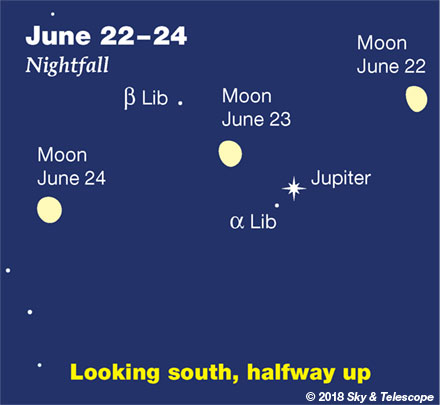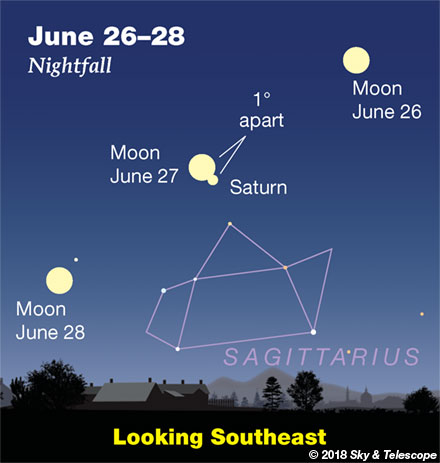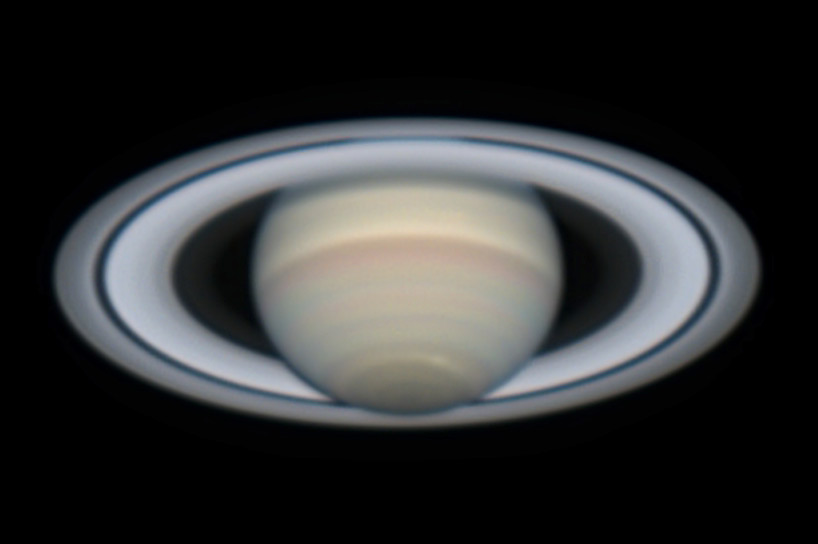
Friday, June 22
• The waxing gibbous Moon this evening shines with bright Jupiter to its lower left and fainter Spica to its lower right.
Saturday, June 23
• The bright "star" with the Moon tonight is Jupiter. Although they look rather close together, Jupiter is currently 1,800 times farther away — and it's 40 times larger in diameter.
• This is the time of year when the two brightest stars of summer, Arcturus and Vega, shine about equally high overhead soon after dark: Arcturus toward the southwest, Vega toward the east.
Arcturus and Vega are 37 and 25 light-years away, respectively. They represent the two commonest types of naked-eye stars: a yellow-orange K giant and a white A main-sequence star. They're 150 and 50 times brighter than the Sun, respectively — which, combined with their nearness, is why they dominate the evening sky.
Sunday, June 24
• This evening the Moon forms a long line with Jupiter to its right and Spica a greater distance to the right of Jupiter.
And, look a Jupiter-distance lower left of the Moon to spot orange Antares. Between Antares and the Moon are stars of the head of Scorpius.
Monday, June 25
• This evening the waxing gibbous Moon shines about midway between bright Jupiter to its right or upper right, and Saturn nearly as far to the Moon's lower left. Much closer lower right of the Moon is orange Antares.
Tuesday, June 26
• Now you'll find the nearly full Moon more or less between Antares to its right and Saturn to its lower left.

Wednesday, June 27
• Full Moon tonight (exact at 12:53 a.m. Eastern Daylight Time). The Moon shines only a degree or two from Saturn this evening for North America. Companions they may seem to be, but Saturn is currently 3,400 times farther away. And it's 35 times wider in true diameter.
• Appearing so close to an exactly full Moon, Saturn of course must be very close to opposition! And indeed it is. Saturn was at opposition earlier today, around 9 a.m. Eastern Daylight Time.
Thursday, June 28
• This evening Saturn leads the moon up and across the sky — glowing to its upper right at dusk, then more directly to the Moon's right later in the night.
Friday, June 29
• The waning gibbous Moon rises in the east-southeast in late twilight. An hour later, watch for Mars to clear the horizon about a fist at arm's length to the Moon's lower right (for North America).
Saturday, June 30
• By late evening the Moon and Mars are arisen together, low in the east-southeast.
________________________
Want to become a better astronomer? Learn your way around the constellations! They're the key to locating everything fainter and deeper to hunt with binoculars or a telescope.
This is an outdoor nature hobby. For an easy-to-use constellation guide covering the whole evening sky, use the big monthly map in the center of each issue of Sky & Telescope, the essential guide to astronomy.

Once you get a telescope, to put it to good use you'll need a detailed, large-scale sky atlas (set of charts). The basic standard is the Pocket Sky Atlas (in either the original or Jumbo Edition), which shows stars to magnitude 7.6.
Next up is the larger and deeper Sky Atlas 2000.0, plotting stars to magnitude 8.5; nearly three times as many. The next up, once you know your way around, is the even larger Uranometria 2000.0 (stars to magnitude 9.75). And read how to use sky charts with a telescope.
You'll also want a good deep-sky guidebook, such as Sue French's Deep-Sky Wonders collection (which includes its own charts), Sky Atlas 2000.0 Companion by Strong and Sinnott, or the bigger Night Sky Observer's Guide by Kepple and Sanner.
Can a computerized telescope replace charts? Not for beginners, I don't think, and not on mounts and tripods that are less than top-quality mechanically (meaning heavy and expensive). And as Terence Dickinson and Alan Dyer say in their Backyard Astronomer's Guide, "A full appreciation of the universe cannot come without developing the skills to find things in the sky and understanding how the sky works. This knowledge comes only by spending time under the stars with star maps in hand."
This Week's Planet Roundup

Mercury (about magnitude –0.4) is visible in bright twilight about 20° lower right of Venus. Catch it in the narrow time window between when the sky is still too bright and when Mercury sinks too low and sets.
Don't confuse Mercury with fainter, twinklier Pollux above it early in the week, upper right of it in the following few days, and right of it by about June 28th.
Venus (magnitude –4.0, in Cancer heading toward Leo) shines brightly in the west-northwest during twilight and just after. Find Regulus ever less distant to Venus's upper left, and slightly fainter Algieba upper right of Regulus. In a telescope Venus is a gibbous disk 15 arcseconds tall and 72% sunlit.
Mars, a dramatic magnitude –1.9 in Capricornus, rises only about an hour after dark now. Watch for it to come up 34° lower left of Saturn. Mars is highest in the south, in best view for telescopes, just before the first light of dawn.
Mars is having widespread dust storm! Dust has enveloped much of the planet (though reports of it being "global" are exaggerated), obscuring many major dark surface features and reducing contrast for many others. There are signs that the storm is losing strength, but poor visibility of much of the surface should persist for a long time. See our articles Big Dust Storm Blows up on Mars, updated several times. Here's a June 20th NASA press release.
Mars is brightening on its way to an unusually close opposition at the end of July. It's now 19 or 20 arcseconds wide — bigger than right at most of its oppositions! — and gibbous. It will grow to 24.3 arcseconds for the week around its closest approach on the night of July 30–31.
See also our telescopic guide to Mars in the July Sky & Telescope, page 22. You'll want a Mars map that shows which features are facing Earth at your time and date, such as our Mars Profiler online.
Vesta, the brightest asteroid, is also unusually bright and close. It was at opposition June 19th and remains magnitude 5.3 or 5.4. It's in the Sagittarius Milky Way west of Saturn, heading toward Ophiuchus. Article with finder charts: Vesta Gets Close and Bright.
Jupiter (magnitude –2.4, in Libra) shines in the south in twilight and starts to decline in the southwest later in the evening. It's still 42 arcseconds in equatorial diameter. See our telescopic guide to observing Jupiter in the May Sky & Telescope, page 48.
Saturn (magnitude 0.0, just above the Sagittarius Teapot) glows low in the southeast in twilight. It stands highest in the south around 1 a.m. daylight-saving time, 34° to the upper right of much brighter Mars.
Uranus (magnitude 5.9, at the Aries-Pisces border) and Neptune (magnitude 7.9, in Aquarius) are up in the east and southeast, respectively, just before the beginning of dawn. Finder charts for Uranus and Neptune.
______________________
All descriptions that relate to your horizon — including the words up, down, right, and left — are written for the world's mid-northern latitudes. Descriptions that also depend on longitude (mainly Moon positions) are for North America.
Eastern Daylight Time (EDT) is Universal Time (also called UT, UTC, GMT, or Z time) minus 4 hours.
______________________
"Remember to look up at the stars and not down at your feet. Try to make sense of what you see and wonder about what makes the universe exist. Be curious."
— Stephen Hawking, 1942–2018
______________________
"The dangers of not thinking clearly are much greater now than ever before. It's not that there's something new in our way of thinking, it's that credulous and confused thinking can be much more lethal in ways it was never before."
— Carl Sagan, 1996
______________________
"Objective reality exists. Facts are often determinable. Vaccines save lives. Carbon dioxide warms the globe. Bacteria evolve to thwart antibiotics, because evolution. Science and reason are not a political conspiracy. They are how we determine facts. Civilization's survival depends on our ability, and willingness, to do this."
— Alan MacRobert, your Sky at a Glance editor
______________________
"Facts are stubborn things."
— John Adams, 1770
 4
4








Comments
Rod
June 23, 2018 at 11:30 pm
[Saturday, June 23• The bright "star" with the Moon tonight is Jupiter. Although they look rather close together, Jupiter is currently 1,800 times farther away — and it's 40 times larger in diameter.]
My comment - Very enjoyable view tonight with waxing gibbous Moon and Jupiter near ecliptic in Libra. Favorable libration too visible - Pontecoulant Crater area. I used a 90-mm refractor with TeleVue 32-mm plossl for 31.25x and about 1.6 degree true field. To my south, moonlit towering cumulus clouds near Antares. Quite a sight in the night sky. Viewing along the Patuxent River valley farms in Maryland.
You must be logged in to post a comment.
Tom-Reiland
June 24, 2018 at 10:56 pm
You list the Full Moon at 11:53 PM EDT on Wednesday when it should be 12:53 AM Thursday.
You must be logged in to post a comment.
jrgar1
June 27, 2018 at 9:35 am
We are Daylight Savings TIme now? Spring FORWARD.. LOL!
You must be logged in to post a comment.
jrgar1
June 27, 2018 at 9:37 am
OOPS! Daylight Savings TIME.
You must be logged in to post a comment.
You must be logged in to post a comment.